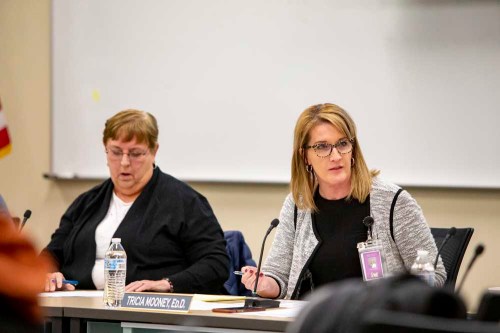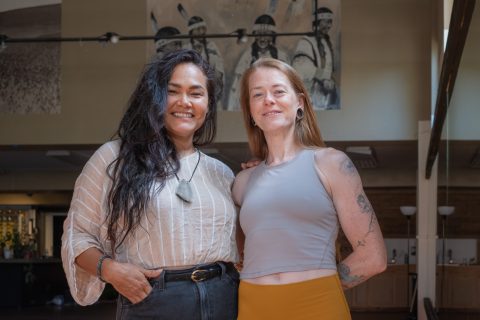State releases guidelines for reopening schools in the fall
Published 7:00 am Thursday, June 11, 2020

- Hermiston School District Superintendent Tricia Mooney, right, speaks March 13, 2020, during an emergency meeting of the Hermiston Board of Education at the Hermiston School District offices. A recent 2022 survey found Oregonians don’t have much support for their local school boards.
UMATILLA COUNTY — This fall, Oregon’s K-12 students may finally get to return to their classrooms for the first time in half a year, based on new state safety guidelines. But school won’t look the same as it did before COVID-19.
New behaviors and rituals will need to be learned: Desks will be 6 feet apart. Face coverings will be required for most school staff. Elementary students won’t share glue sticks.
Trending
“There is no doubt this spring was hard on students, families, and educators,” said a statement signed by state education and health directors Colt Gill and Pat Allen. “And yet, we believe returning to school, the planning it will require, and the shifts in adult and student behavior it will require will be even more difficult.”
Much of the state’s long list of reopening requirements and recommendations released Wednesday, June 10 fall under a few ideals: Keep students and staff at a distance from each other, wipe down and sanitize objects frequently, and make sure everyone washes their hands as often as possible.
Hermiston School District Superintendent Tricia Mooney said the good news is the release of the guidelines means the district is one step closer to being able to have students back in their buildings.
“There’s a lot to digest in that, and with it released today (June 10), at the district level we will put together a team to look at it and put a plan together,” she said.
Mooney said the district had already budgeted to increase its number of school nurses from two to four next year, and after working throughout the summer to come up with building-by-building protocols, will train staff in time to resume classes on Aug. 24.
“In Hermiston, we’ve been able to keep class sizes manageable, which is very beneficial in following these guidelines,” she said.
Trending
Mooney said the district already makes accommodations as needed for students with medical conditions, and will continue to adjust those accommodations to serve students with underlying health conditions that would put them at higher risk of complications from COVID-19.
When school resumes in the fall, schools will be required to keep students in isolated groups, or cohorts, whenever possible. Cohorts must allow for at least 35 square feet per person, including staff, and they’ll be assigned certain spaces only for their use. That includes bathrooms as well as classrooms, according to the state.
The state guidelines admit keeping students in rigid cohorts is harder in middle and high schools — where students see multiple teachers in a day — but the state still recommends that all schools make plans to reduce mixing student cohorts.
School schedules will also be modified to keep as few students in hallways and shared spaces as possible.
Furthermore, just about every object in schools that students touch, from desks to school bus seats to library books, should be sanitized frequently, according to the state.
Face masks and coverings will be required for all staff who are regularly within 6 feet of other people in school, bus drivers, staff who prepare and/or serve meals, and school visitors. Front office staff will be required to wear larger, plastic face shields, or be behind a plastic barrier.
Students will not be required to wear face masks — although it is recommended, particularly for middle and high school students, who will have to mix with other students more often — and schools must continue to educate students who don’t wear masks.
Frequent hand washing will be recommended for students and staff, and required before eating meals. Elementary students will be required to wash their hands before and after using playground equipment.
Before walking into a school building or school bus, each student and staff member must be screened for COVID-19 symptoms. On a conference call with journalists, Dr. Tom Jeanne of Oregon Health and Science University said because temperature isn’t always a reliable symptom of COVID-19 for children and teens, the state is not planning to have schools check temperatures at the door, but staff can do a visual check for obvious symptoms such as a cough.
Most important, he said, will be parents monitoring their own child’s health and not sending them to school with symptoms.
Every school district and private school will need to fill out a state form, a blueprint for reopening with checklists of requirements to keep students and staff safe.
If a school district chooses to stick with temporary distance learning, or a hybrid of in-school and distance learning, the district must describe how that will look for its students and staff. State education director Colt Gill told journalists that if a school needed to do an A/B day schedule, for example, where only half the students were in the building on a given day, the district would need to provide class online to the students who were out of the building that day.
He also stated that they will need to provide online learning for students with underlying conditions that put them at higher risk, and must have plans in place for temporary shutdowns of classrooms or schools should there be an outbreak there.
Districts receiving federal grants for disadvantaged students must also consult with local tribal agencies before sending in its completed checklist. School districts should also meet with students, families and other community groups to shape their individual plan, the state recommended.
Then, school districts’ reentry forms must be approved by a series of groups, in this order: the local school board, the local public health agency and the Oregon Department of Education. These blueprints for reentry must also be posted to school district and school websites for the public to see.
Pendleton School District Superintendent Chris Fritsch said superintendents only got the guidelines a few minutes before the public did, so it will take a few days to dissect the information and put together a blueprint for the fall. But he said the guidelines give the district the tools it needs to work toward being ready for students to walk through the doors on the district’s scheduled Sept. 1 start.
“We’ve been working closely with Umatilla County Public Health through all of this and already have some communication lines open there,” he said.









